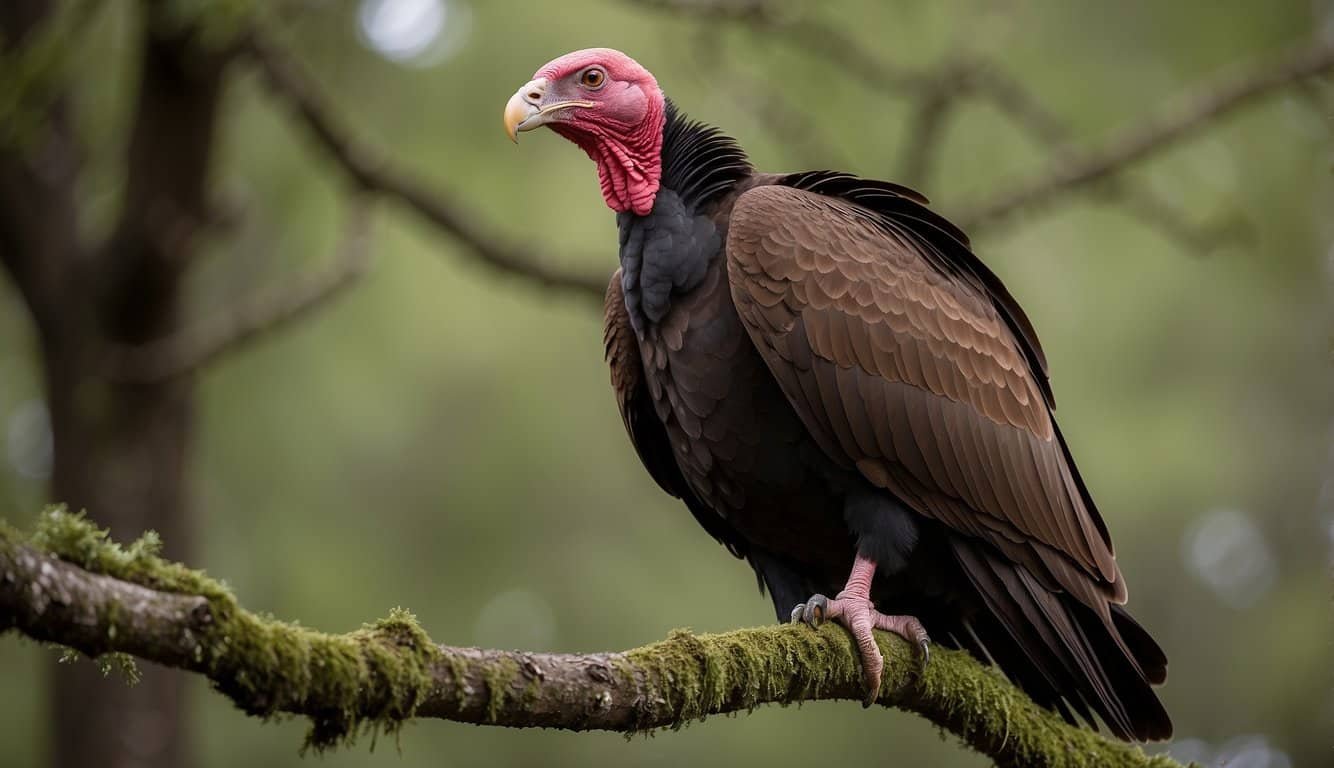Turkey Vulture Overview
The turkey vulture is a fascinating bird that plays a critical role in the ecosystem. Known for its large size and distinctive red head, this scavenger is a sight to behold in the expansive skies of North America.
Physical Features
Turkey vultures are easily recognized by their two-toned wings and a wingspan that can reach an impressive 170 to 178 cm. The underwing coverts are paler, giving them a two-toned appearance in flight. Their body length can vary between 62 to 81 cm, with an average weight ranging from 0.8 to 2.4 kilograms. Perhaps one of the turkey vulture’s most notable features is its red head, which is devoid of feathers, contrasting sharply with its dark body.
Scientific Classification
The turkey vulture, scientifically known as Cathartes aura, belongs to the family Cathartidae. This family encompasses the New World vultures and includes several other species closely related to the turkey vulture. They are often referred to by the alternative name “turkey buzzard,” particularly in the southern United States.
Conservation Status
According to the IUCN Red List, turkey vultures are currently classified as “Least Concern.” Their population appears stable across their broad range, which spans from Canada to the southern tip of South America. Their conservation success is partially due to their adaptability in various habitats and their role as nature’s cleanup crew, feeding on carrion without directly competing with predators.
Behavior and Ecology

Turkey vultures are noted for their exceptional smelling ability and play a crucial role in many ecosystems as scavengers. Let’s explore how these birds interact with their environment through their diet, reproduction habits, and distinctive flight patterns.
Diet and Scavenging
Turkey vultures are predominantly scavengers, relying on their keen sense of smell to locate carrion. They eat a variety of dead animals, making them an important part of the ecosystem as they help to dispose of carrion before it can become a health hazard. Surprisingly, these birds have a highly developed olfactory system, unusual for avian species, which allows them to detect carcasses over large areas. Aside from larger mammals, their diet can also include fish, insects, and reptiles when available.
- Sniffing out dinner: Locating carrion by smell, potentially from miles away
- Varied appetite: Consuming dead mammals, fish, reptiles, and insects
Reproduction and Nesting
When it comes to breeding, turkey vultures prefer the solitude of hidden nooks. They do not construct traditional nests; instead, they lay eggs in sheltered areas like caves, thickets, hollow trees, and crevices in cliffs. The breeding season is a time of partnership, as both parents are involved in incubating the eggs and raising the young. Typically, a turkey vulture will lay one to three eggs, and the hatchlings will emerge after an incubation period of about 30 to 40 days.
- Intimate nesting: Utilizing natural shelters without constructing typical nests
- Co-parenting: Both parents incubate eggs and care for offspring
Flight Patterns
These birds are masters of the sky. Utilizing thermals, turkey vultures can soar elegantly without expending much energy. They fly with their wings raised in a slight V-shape and often tilt side-to-side, a behavior known as a “rock,” which helps them keep their balance. Migratory by nature, they travel long distances between seasons, showcasing their impressive energy efficiency. Flight behavior has a significant risk of collision with aircraft, highlighting a need for understanding their aerial movements better.
- Effortless flying: Soaring on thermals with minimal energy expenditure
- Navigating airways: Migrating long distances and avoiding collisions
Turkey vultures showcase some of nature’s most impressive adaptations, from their remarkable sense of smell that aids in feeding to their efficient and powerful flight. Their role as nature’s cleanup crew is not only fascinating but essential for the health of many ecosystems.
Identification and Observation

When setting out to identify turkey vultures, it is crucial to note both their physical characteristics and their unique behaviors. Being equipped with such knowledge allows for clear distinction from other raptors in North America.
Spotting Turkey Vultures
Turkey vultures are often seen soaring in the sky with their wings held in a shallow ‘V’ shape. Their long wings have a span that typically ranges from 63 to 72 inches, aiding in their notable gliding flight. One can identify them by their dark brown body and featherless red head, which in adults, stands out against the sky. Juveniles have a darker head that can be confused with that of the similar-looking, black vulture, although black vultures have shorter tails and wings with a white patch at the wing tips, which turkey vultures lack.
Turkey vultures prefer open areas for foraging—these include road sides, suburban areas, and open woods. One might also spot them on roosts that are made on rocks or even man-made structures such as buildings. Their presence at roadsides is often a telltale sign, as these birds seek out carrion for their meals.
Behavioral Characteristics
Distinct from eagles, hawks, and other raptors, turkey vultures are not known to hunt live prey. Instead, they feed on carrion, which they locate by their keen sense of smell—a relatively rare trait among birds. Observing their behavior around potential food sources can reveal interesting rituals, such as regurgitation, a defense mechanism used to deter predators or lighten the bird for flight.
In communal roosts, turkey vultures can be seen engaging in social behaviors with one another. They follow a migratory pattern, traveling to breeding grounds, which led to their protection under the Migratory Bird Treaty Act. The act of regurgitating undigested food at roost sites performs a dual role of feeding the young and repelling intruders.
While they may share their habitat with other raptors like the red-tailed hawk or even the larger condors, turkey vultures are distinguished by their social nature and specific feeding habits. Observing these birds in their preferred open habitats offers insight into their role as nature’s clean-up crew.

